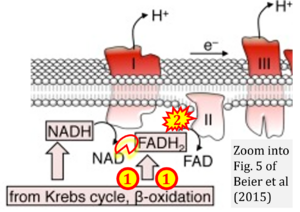Beier 2015 FASEB J
| Beier UH, Angelin A, Akimova T, Wang L, Liu Y, Xiao H, Koike MA, Hancock SA, Bhatti TR, Han R, Jiao J, Veasey SC, Sims CA, Baur JA, Wallace DC, Hancock WW (2015) Essential role of mitochondrial energy metabolism in Foxp3⁺ T-regulatory cell function and allograft survival. FASEB J 29:2315-26. https://doi.org/10.1096/fj.14-268409 |
Beier UH, Angelin A, Akimova T, Wang L, Liu Y, Xiao H, Koike MA, Hancock SA, Bhatti TR, Han R, Jiao J, Veasey SC, Sims CA, Baur JA, Wallace DC, Hancock WW (2015) FASEB J
Abstract: Conventional T (Tcon) cells and Foxp3(+) T-regulatory (Treg) cells are thought to have differing metabolic requirements, but little is known of mitochondrial functions within these cell populations in vivo. In murine studies, we found that activation of both Tcon and Treg cells led to myocyte enhancer factor 2 (Mef2)-induced expression of genes important to oxidative phosphorylation (OXPHOS). Inhibition of OXPHOS impaired both Tcon and Treg cell function compared to wild-type cells but disproportionally affected Treg cells. Deletion of Pgc1α or Sirt3, which are key regulators of OXPHOS, abrogated Treg-dependent suppressive function and impaired allograft survival. Mef2 is inhibited by histone/protein deacetylase-9 (Hdac9), and Hdac9 deletion increased Treg suppressive function. Hdac9(-/-) Treg showed increased expression of Pgc1α and Sirt3, and improved mitochondrial respiration, compared to wild-type Treg cells. Our data show that key OXPHOS regulators are required for optimal Treg function and Treg-dependent allograft acceptance. These findings provide a novel approach to increase Treg function and give insights into the fundamental mechanisms by which mitochondrial energy metabolism regulates immune cell functions in vivo.
• Bioblast editor: Gnaiger E • O2k-Network Lab: US PA Philadelphia Wallace DC, US OH Columbus Sims CA
Labels: MiParea: Respiration, nDNA;cell genetics
Organism: Mouse
Tissue;cell: Nervous system
Preparation: Homogenate
Enzyme: Complex II;succinate dehydrogenase
Coupling state: LEAK, OXPHOS, ET Pathway: N, S, NS, ROX HRR: Oxygraph-2k
Etomoxir
Correction: FADH2 and Complex II
- FADH2 is shown as the substrate feeding electrons into Complex II (CII). This is wrong and requires correction - for details see Gnaiger (2024).
- Gnaiger E (2024) Complex II ambiguities ― FADH2 in the electron transfer system. J Biol Chem 300:105470. https://doi.org/10.1016/j.jbc.2023.105470 - »Bioblast link«
Hydrogen ion ambiguities in the electron transfer system
Communicated by Gnaiger E (2023-10-08) last update 2023-11-10
- Electron (e-) transfer linked to hydrogen ion (hydron; H+) transfer is a fundamental concept in the field of bioenergetics, critical for understanding redox-coupled energy transformations.
- However, the current literature contains inconsistencies regarding H+ formation on the negative side of bioenergetic membranes, such as the matrix side of the mitochondrial inner membrane, when NADH is oxidized during oxidative phosphorylation (OXPHOS). Ambiguities arise when examining the oxidation of NADH by respiratory Complex I or succinate by Complex II.
- Oxidation of NADH or succinate involves a two-electron transfer of 2{H++e-} to FMN or FAD, respectively. Figures indicating a single electron e- transferred from NADH or succinate lack accuracy.
- The oxidized NAD+ is distinguished from NAD indicating nicotinamide adenine dinucleotide independent of oxidation state.
- NADH + H+ → NAD+ +2{H++e-} is the oxidation half-reaction in this H+-linked electron transfer represented as 2{H++e-} (Gnaiger 2023). Putative H+ formation shown as NADH → NAD+ + H+ conflicts with chemiosmotic coupling stoichiometries between H+ translocation across the coupling membrane and electron transfer to oxygen. Ensuring clarity in this complex field is imperative to tackle the apparent ambiguity crisis and prevent confusion, particularly in light of the increasing number of interdisciplinary publications on bioenergetics concerning diagnostic and clinical applications of OXPHOS analysis.




